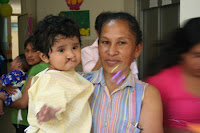Mission Story:
Imagine a skinny, gaunt man holding onto his son, protecting him from the outside world of mockery while hoping, wishing for the chance for his son to be chosen to be one of the 115 patients to have surgery. The power of love that is expressed between this father and son is undeniably the most powerful thing on the earth. This father only hopes that he can look at his son one day and see that he is not ashamed of his gorgeous smile. This is Wilber Massaby, a soft spoken man with an incredible love for his son that was clear to everyone around.
Now look to through my eyes to a bench outside the post-op wing and see a young woman with light in her eyes as she talks adoringly of her eight month year old son and the new hope she has for his life. Then suddenly her emotions turn to anguish and tears well in her eyes as she recounts the action of his father who left them upon seeing his son's cleft lip. Watch the tears stream down her face as she recounts this emotional wound. This is Graciela Vargas, the mother of a baby with a cleft lip who was abandoned by her husband.
Step in my shoes and witness a grandmother who dotes on her grandson. Her joy for him is translated on his happy face that never ceased to smile. This amazing woman took on the responsibility of raising her grandson when his father walked out on him and as his mother struggles to connect with her son due to his cleft lip. Watch both laugh as bubbles blow by their faces and watch as this little boy waves goodbye as he leaves the hospital. This is Rosa Carreña, a grandmother who stepped - in to take care of her grandson and teaches him to enjoy life and smile big.

On my mission it was heartbreaking to realize that many fathers weren't present in their child's life. Wilber's love for his son was opposite to that of the many fathers who abandon their children upon birth like Graciela Vargas' husband. When Wilber saw his son, Jose Maria had a cleft lip he accepted it. Instead of disappointment, he was filled with an insurmountable love for his child. Just because his son had a cleft palate, he was still his son. Jose was not abandoned or denied by his father, he was accepted, loved, and cared for by him. When Wilber spoke of his son, he spoke quietly, and when he talked about his love for his son he was matter-of-fact. The bottom line for Wilber is that Jose is his son and he has to take care of him. There was no debate about whether to come to Santa Cruz for the Massaby’s. It was a stepping stone for Jose’s future and the opportunity to change the life of a family and of a child. I visited the Massaby’s by the post-op crib where Jose slept. It was stiflingly hot in the room; about six children were laying in their cribs and parents watched on. Wilber was one of two dads I saw in the room. I observed all of this as I stood in the doorway, but what touched my heart was the way Wilber gazed lovingly down at his sleeping son. He did not need to tell us he was happy. It was written all over his face.
Operation Smile gave the Massaby’s the chance to give their son a normal life. Although only two, Wilber relayed that people stare at his son and judge him. On the exterior they see a deformity but the beautiful interior is what they failed to notice. Jose is a sweet, fun loving child and Operation Smile gave him the opportunity to go in public without scorn, to begin to talk, and to start living life normally without worrying about mundane occurrences such as eating. As I sat by Wilber, I watched Jose grab a cup of Jello and take a big gulp, something he could not do previously. The effect: a huge grin on Mom, Dad, and Baby’s face.












